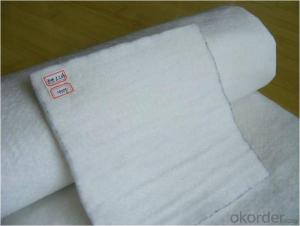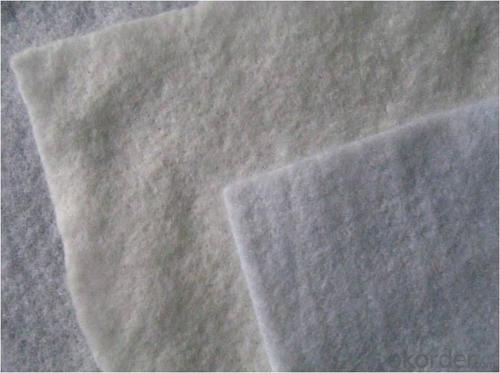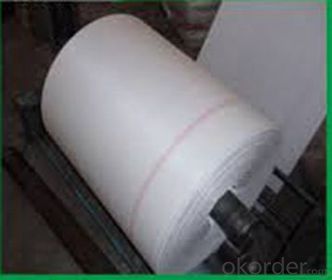Woven Polypropylene Geotextile Fabric for Road Construction CNBM
- Loading Port:
- China main port
- Payment Terms:
- TT OR LC
- Min Order Qty:
- 4000 m²
- Supply Capability:
- 1000000 m²/month
OKorder Service Pledge
OKorder Financial Service
You Might Also Like
Specification
Product Description:
Nonwoven Geotextile Fabric for Road Construction Geotextile
Product Features
|



After-sales service
1.In order to provide customers with comprehensive technical support,we will provide technical and other related information upon request in a timely manner.
2.In required,we will appoint specialized technicians to the construction site to give technical trainings to construction people,and offer technical guidance throughout the whole construction process.
3.For damage due to shipment and delivery,after we receive the complaint,we will check the issure through provided pictures and videos.If our responsibility is confirmed,we wil offer free replacement.
4.When the construction is completed,as your request,our technical staff may participate in the final acceptance.
FAQ:
Q: What kind of payments does jenor support?
A: T/T, L/C, Cash are accepted.
Q: Do you charge for the samples?
A: Accordeing to our company policy, the samples are free, we only charge the freight fee. And we will return the freight fee during the next order.
Q: Can you produce according to customers' design?
A: Sure, we are professional manufacturer, OEM and ODM are both welcome.
Q: Do you have other products?
A: Yes, please check the pictures:
Packaging & Shipping
Packing: PLASTIC FILM INSIDE, AND WOVEN BAG OUTSIDE
Shipping: About 15 days after receipt the deposit
geotextile fabric
permeability,filtration,easy for construction
ISO and CE certificate
Good quality and competitive price
- Q: What are the specifications for geotextiles in subsurface drainage projects?
- The specifications for geotextiles in subsurface drainage projects can vary depending on the specific project requirements. However, some common specifications include the desired tensile strength, puncture resistance, and permeability of the geotextile. Additionally, the required thickness, weight, and filtration efficiency may also be specified. It is important to consult the project specifications and consider factors such as soil type, groundwater conditions, and anticipated loads to determine the appropriate specifications for geotextiles in subsurface drainage projects.
- Q: How much is the price of anti-geotextile?
- In the actual engineering procurement, generally between the two geotextiles need about> 250px lap, so the procurement is usually based on the actual area plus 15% to 20% loss. Hongxiang new material Li Qian geotextile price is also required according to the specific needs of the project to specify the model, the specific offer.
- Q: Mainly on the cement concrete laying asphalt overlay and deck pavement, a bit puzzled, sticky words and how to design more
- Geotextile in the following
- Q: How do geotextiles help in groundwater drainage?
- Geotextiles help in groundwater drainage by allowing water to pass through while preventing soil particles from clogging the drainage system. They act as a filter, providing a barrier against soil erosion and maintaining the permeability of the drainage system, thus improving the overall efficiency of groundwater drainage.
- Q: Are geotextiles resistant to freeze-thaw cycles?
- Yes, geotextiles are generally resistant to freeze-thaw cycles. Geotextiles are designed to withstand various environmental conditions, including freezing temperatures and the subsequent expansion and contraction of soil during freeze-thaw cycles. Their properties, such as high tensile strength and durability, allow them to maintain their structural integrity and functionality in such conditions.
- Q: What are the different geotextile durability test methods?
- There are several geotextile durability test methods used to assess the performance and longevity of geotextile materials. Some of the commonly used test methods include ASTM D4355 (Oxidative Induction Time), ASTM D1777 (Hydrostatic Puncture Resistance), ASTM D4533 (Trapezoidal Tear Strength), ASTM D4751 (Apparent Opening Size), ASTM D4759 (UV Stability), and ISO 12956 (Cyclic Load Test). These tests evaluate factors such as resistance to oxidation, puncture resistance, tear strength, opening size, UV stability, and cyclic load performance, providing insights into the durability and suitability of geotextile materials for specific applications.
- Q: What are the factors to consider when selecting a geotextile?
- When selecting a geotextile, there are several factors to consider. These include the specific application or project requirements, the physical and mechanical properties of the geotextile, the site conditions and environmental factors, the expected lifespan and durability of the geotextile, and the cost-effectiveness of the product. It is important to assess these factors to ensure that the chosen geotextile will effectively meet the project needs and provide long-term performance.
- Q: What are the different geotextile permeability testing methods?
- There are several different geotextile permeability testing methods, including the constant head method, falling head method, and gradient ratio method.
- Q: What are the key considerations for geotextile installation in seismic retrofitting projects?
- Some key considerations for geotextile installation in seismic retrofitting projects include selecting the appropriate type and strength of geotextile material, ensuring proper placement and anchoring of the geotextile, evaluating the stability and drainage requirements of the site, and considering the compatibility of the geotextile with other materials and construction methods used in the retrofitting project. Additionally, careful attention should be given to the design and installation of the geotextile to ensure it effectively enhances the overall stability and performance of the structure during seismic events.
- Q: How do geotextiles help with pavement maintenance?
- Geotextiles help with pavement maintenance by acting as a barrier between the subgrade soil and the pavement layers, preventing the mixing and migration of soil particles. This helps to maintain the structural integrity of the pavement, reducing the chances of cracks, potholes, and other damages caused by the movement of underlying soil. Additionally, geotextiles can improve drainage and filtration, reducing the risk of water accumulation beneath the pavement and extending its lifespan.
Send your message to us
Woven Polypropylene Geotextile Fabric for Road Construction CNBM
- Loading Port:
- China main port
- Payment Terms:
- TT OR LC
- Min Order Qty:
- 4000 m²
- Supply Capability:
- 1000000 m²/month
OKorder Service Pledge
OKorder Financial Service
Similar products
Hot products
Hot Searches
Related keywords


































